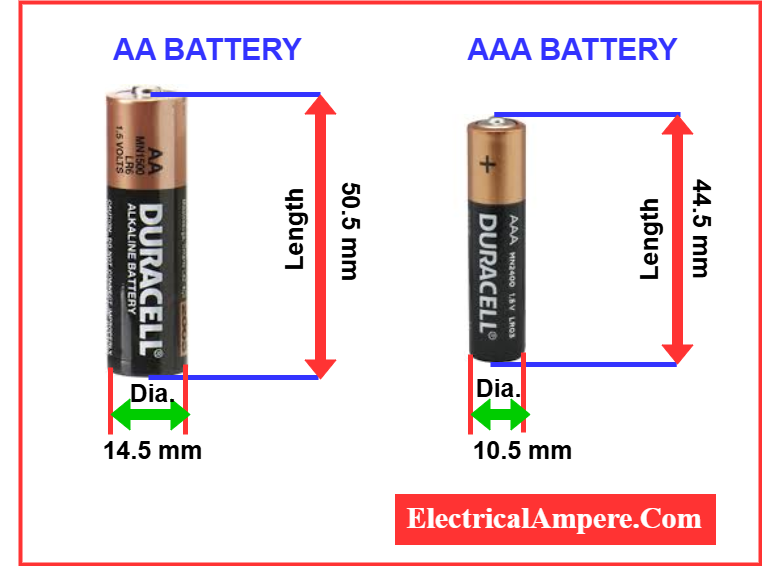Discover the key difference between AA and AAA battery, including size, capacity, applications, and voltage. Learn which battery suits your device and how to use them effectively.
AA and AAA batteries are both cylindrical in shape, but they differ in size, power, and capacity. AA batteries are larger and generally deliver more power, making them suitable for high power devices. In contrast, AAA batteries are smaller and are typically used in low-power devices.
Batteries are the lifeblood of countless electronic gadgets—from remote controls to digital cameras. Among the most commonly used types are AA and AAA batteries. While they may appear similar, these two battery types differ in several crucial aspects, including size, capacity, and application.
In this article, we will explore the difference between AA and AAA batteries, with practical examples, technical insights, and key usage recommendations.
What Are AA and AAA Batteries?
The terms AA and AAA don’t stand for any technical definition but are simply standardized designations given to batteries based on their physical dimensions and voltage ratings.
- AA battery dimensions: 50.5 mm (length) × 14.5 mm (diameter)
- AAA battery dimensions: 44.5 mm (length) × 10.5 mm (diameter)

Despite the size difference, both AA and AAA batteries provide a nominal voltage of 1.5 volts per cell.
Why Battery Size Matters
The size of the battery is essential because devices are designed to hold specific battery dimensions. A larger AA battery cannot fit in a AAA battery slot and vice versa. Some battery adapters are available to make AA batteries fit AAA slots, but these are rarely used in consumer electronics due to practicality and space constraints.
Example:
- A TV remote control typically uses AAA batteries.
- A digital camera or a handheld gaming device may require AA batteries for more power.
Voltage and Capacity: The Core Differences
While both AA and AAA batteries supply 1.5 volts, their charge storage capacities differ significantly.
| Battery Type | Voltage | Typical Capacity (mAh) | Common Use |
|---|---|---|---|
| AA | 1.5 V | 2000–3000 mAh | Cameras, toys, torches |
| AAA | 1.5 V | 800–1200 mAh | Remotes, clocks, wireless mice |
Note: Capacity refers to the amount of charge the battery can store. Higher mAh means the battery will last longer in high-drain devices.
Series Connection for Higher Voltage
Need more voltage? Connect multiple cells in series. This stacks up their voltages.
Example:
To achieve 9V:
- Use 6 AA or 6 AAA batteries in series.
- 1.5V × 6 = 9V total output.
Such setups are commonly found in:
- Portable radios
- Toy cars
- Flashlights
Which Devices Use AA vs AAA Batteries?
AA Battery Applications:
- Flashlights
- Digital cameras
- Portable radios
- Wireless gaming controllers
- Battery-powered fans
AAA Battery Applications:
- TV remotes
- Wall clocks
- Wireless computer accessories (mouse/keyboard)
- Thermometers
- LED string lights
Are AA and AAA Batteries Recyclable?
Yes. Most alkaline batteries (both AA and AAA) are made from non-toxic materials such as:
- Zinc
- Manganese
- Steel
- Potassium
- Graphite
- Paper and plastic
These materials make them safe to dispose of or recycle. Many local recycling programs accept used batteries.
What About Rechargeable AA and AAA Batteries?
Rechargeable versions of AA and AAA batteries are available in NiMH (Nickel-Metal Hydride) and Li-ion (Lithium-ion) chemistries.
Important Tip:
Use a charger that supports both sizes. Many modern battery chargers have adjustable slots for AA and AAA batteries.
Quick Comparison: AA vs AAA Batteries
| Feature | AA Battery | AAA Battery |
|---|---|---|
| Size | Larger (50.5 mm × 14.5 mm) | Smaller (44.5 mm × 10.5 mm) |
| Voltage | 1.5V | 1.5V |
| Capacity | 2000–3000 mAh | 800–1200 mAh |
| Weight | Heavier | Lighter |
| Used In | High-power devices | Low-power devices |
| Lifespan in same device | Longer | Shorter |
| Cost | Slightly more expensive | Slightly cheaper |
Conclusion
The difference between AA and AAA batteries lies mainly in their size and capacity. AA batteries are better suited for power-hungry devices, while AAA batteries are ideal for compact, low-power gadgets. Knowing which battery to use ensures optimum performance and efficiency of your electronic devices.
Always check your device’s manual or battery compartment label to determine the appropriate battery size.
FAQs
Q1: Can I use a AAA battery in place of an AA battery?
No. AAA batteries are smaller and won’t fit properly or deliver the same capacity.
Q2: Are AA batteries more powerful than AAA?
Yes. AA batteries have higher capacity and are better for devices requiring more current.
Q3: Can I recharge alkaline AA and AAA batteries?
Standard alkaline batteries are not rechargeable. However, rechargeable versions like NiMH and Li-ion are available.
Related Articles: